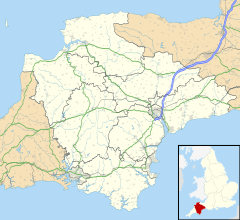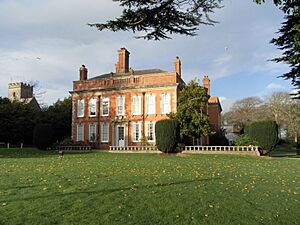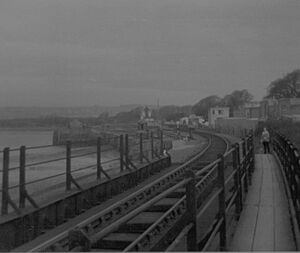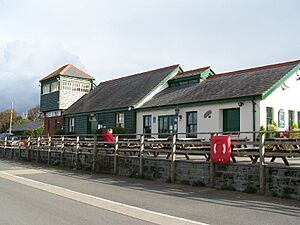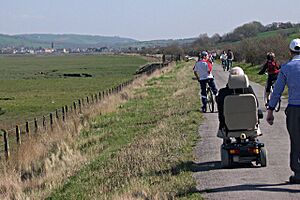Fremington, Devon facts for kids
Quick facts for kids Fremington |
|
|---|---|
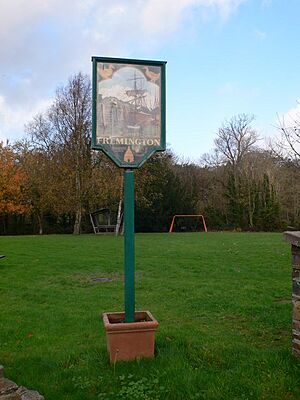 Sign on the village green |
|
| Population | 4,310 2011 census |
| District |
|
| Shire county | |
| Region | |
| Country | England |
| Sovereign state | United Kingdom |
| Post town | BARNSTAPLE |
| Postcode district | EX31 |
| Police | Devon and Cornwall |
| Fire | Devon and Somerset |
| Ambulance | South Western |
| EU Parliament | South West England |
Fremington is a large village in North Devon, England. It's also a civil parish, which is like a local government area. The village used to be a manor, which was a large estate ruled by a lord. Fremington is about 3 miles (5 km) west of Barnstaple.
The village is located between the River Taw estuary (where the river meets the sea) and a small inlet called Fremington Pill. The area around Fremington includes the nearby places of Bickington and Yelland. These areas have grown a lot, with many houses for people who work in Barnstaple. Even so, some old buildings still stand near the church.
Contents
- A Look Back at Fremington's Past
- How Fremington's Population Grew
- Fremington Manor House
- Fremington's Clay Works
- Fremington Quay: A Busy Port
- Getting Around Fremington
- Learning in Fremington
- Community and Fun
- Places to Visit
- St Peter's Church
- Sports in Fremington
- The Railway and Tarka Trail
- Fremington Army Camp
- See also
A Look Back at Fremington's Past
Fremington was once part of a larger area called a hundred, which was an old way of dividing up land. Because it had a busy quay (a dock for ships) and was allowed to hold markets, Fremington was briefly a borough. This meant it could send people to represent it in Parliament during the time of King Edward III (who ruled from 1327 to 1377).
The land of Fremington was owned by the Acland family for a long time. They were a very important family in the Southwest of England. Later, the manor was given to John Holland, who was King Richard II's half-brother. After John Holland rebelled against the new king, Henry IV, the manor was given to others.
How Fremington's Population Grew
The number of people living in Fremington has changed a lot over the years. In 1801, there were 875 people. This number slowly grew to 1,326 by 1841. But then, when the railway arrived, the population actually went down for a while.
After World War II, Fremington started growing much faster. Between 1961 and 2011, the population more than doubled, reaching 4,310 people.
| Year | 1801 | 1811 | 1821 | 1831 | 1841 | 1851 | 1881 | 1891 | 1901 |
|---|---|---|---|---|---|---|---|---|---|
| Population | 875 | 941 | 1,099 | 1,180 | 1,326 | 1,350 | 1,235 | 1,195 | 1,194 |
| Year | 1911 | 1921 | 1931 | 1941 | 1951 | 1961 | 2001 | 2011 | |
| Population | 1,200 | 1,120 | 1,172 | n/a | 2,734 | 4,409 | 3,923 | 4,310 |
Fremington Manor House
Fremington Manor is a large, old house made of red brick. It's located near St Peter's Church and you can see it from the main road. This house was built by Richard II Acland, who was a Member of Parliament. It was later updated in the 1800s by the Arundell-Yeo family.
Between 1943 and 1945, during World War II, Fremington Manor and its land were used by the US Army as a hospital and place for soldiers to recover. After the war, the British Army used it as a training center. In the 1970s, it was still an army training camp. In 1980, the army sold Fremington Manor, and it became a nursing home. The larger army camp nearby closed in 2009.
Fremington's Clay Works
Fremington is known for its special "Fishley Pottery," which was made by the Fishley family in the Combrew area. You can see examples of their work in the Museum of Barnstaple and North Devon. The area had excellent clay pits, which were used by other pottery companies too. This clay was very good because it didn't have many stones in it.
Scientists believe this special clay might have formed near ancient ice sheets that covered Fremington a very long time ago. It's unusual to find these types of clay deposits in Devon.
Fremington Quay: A Busy Port
Fremington Quay was once a very important port on the River Taw. It had railway tracks, cranes, and other equipment. It was used to send out "ball clay" (a type of clay used in pottery) and bring in coal. In the early to mid-1900s, it was one of the busiest ports between Bristol and Land's End (the very tip of Cornwall).
Today, Fremington Quay has been updated and is a nice place for people to visit. It has a restaurant and offers great views over the River Taw estuary. It has been a special "Conservation Area" since 1996, meaning its history and natural beauty are protected.
Getting Around Fremington
The main road, the A39, used to go right through the village. But in 1989, a new section of the road was built about 2 miles (3 km) south of the village. This helped reduce the summer traffic jams in Fremington.
Buses also serve Fremington. You can catch buses like Stagecoach Devon 21/21A, which goes to Barnstaple, Bideford, and Westward Ho!, and Stagecoach Devon 5B, which goes to Barnstaple and Exeter.
Learning in Fremington
The West Fremington Presbyterian School for Boys was started in 1873. The old school building was sold in 1982 and became a private home. Today, the main school is Fremington Community Primary & Nursery School, which is located in the newer part of the village.
Community and Fun
Fremington is famous for its "great meat pie," which is even mentioned in a song! The local council provides places for sports and outdoor activities. There's also a village hall that people can rent for events. A community group helps raise money for good causes, and there's even a 1st Fremington Air Scouts group in the village.
Places to Visit
Fremington has two pubs, The Fox and the New Inn, which are almost next door to each other.
Little Bridge House in the village is a special place. It's a children's hospice run by Children's Hospice South West, which provides care for children with life-limiting conditions.
St Peter's Church

The parish church, St Peter's, was completely renovated in 1867 by a famous architect named Sir George Gilbert Scott. The stone pulpit inside the church was actually buried during the English Reformation (a time of big changes in the church) and still has traces of its original color. The church's medieval tower is unusual because it's located at the east end of the church, next to the main altar area.
Sports in Fremington
A greyhound racing track opened in Fremington in 1937. It was an independent track, meaning it wasn't part of the main racing organization. Races were held over distances of 340 yards and 400 yards, but the track only operated for about two years.
The Railway and Tarka Trail
The Tarka Trail is a popular path for cycling and walking. It follows the route of an old railway line that used to run from Barnstaple to Torrington. This trail crosses Fremington Pill on an old iron railway bridge. The railway line closed in 1982 and the tracks were removed in 1987.
The original railway was planned in 1838 and built in 1846. Today, many boats are moored in Fremington Pill. You can also find the 'Quay Cafe' there, which is built to look like an old railway station. However, it's not the original station, which was on the other side of the Tarka Trail. You can still see an old platform from the original station. There are also some old lime kilns (ovens used to make lime) near the Pill.
Fremington Army Camp
The Fremington Army Camp was built close to the railway station at the Quay, so it was easy for soldiers to get there. During World War II, the US Army used the site as a hospital and recovery center for up to 2,000 patients. It started receiving injured soldiers in July 1944.
The camp was also near other military bases, like the Royal Marines Base Chivenor and a Royal Marines training unit at Instow. The army camp closed in 2009 because it wasn't being used enough. Between 2015 and 2020, the land was redeveloped into new housing areas called Riverside Park and Water's Edge.
See also
 In Spanish: Fremington para niños
In Spanish: Fremington para niños


